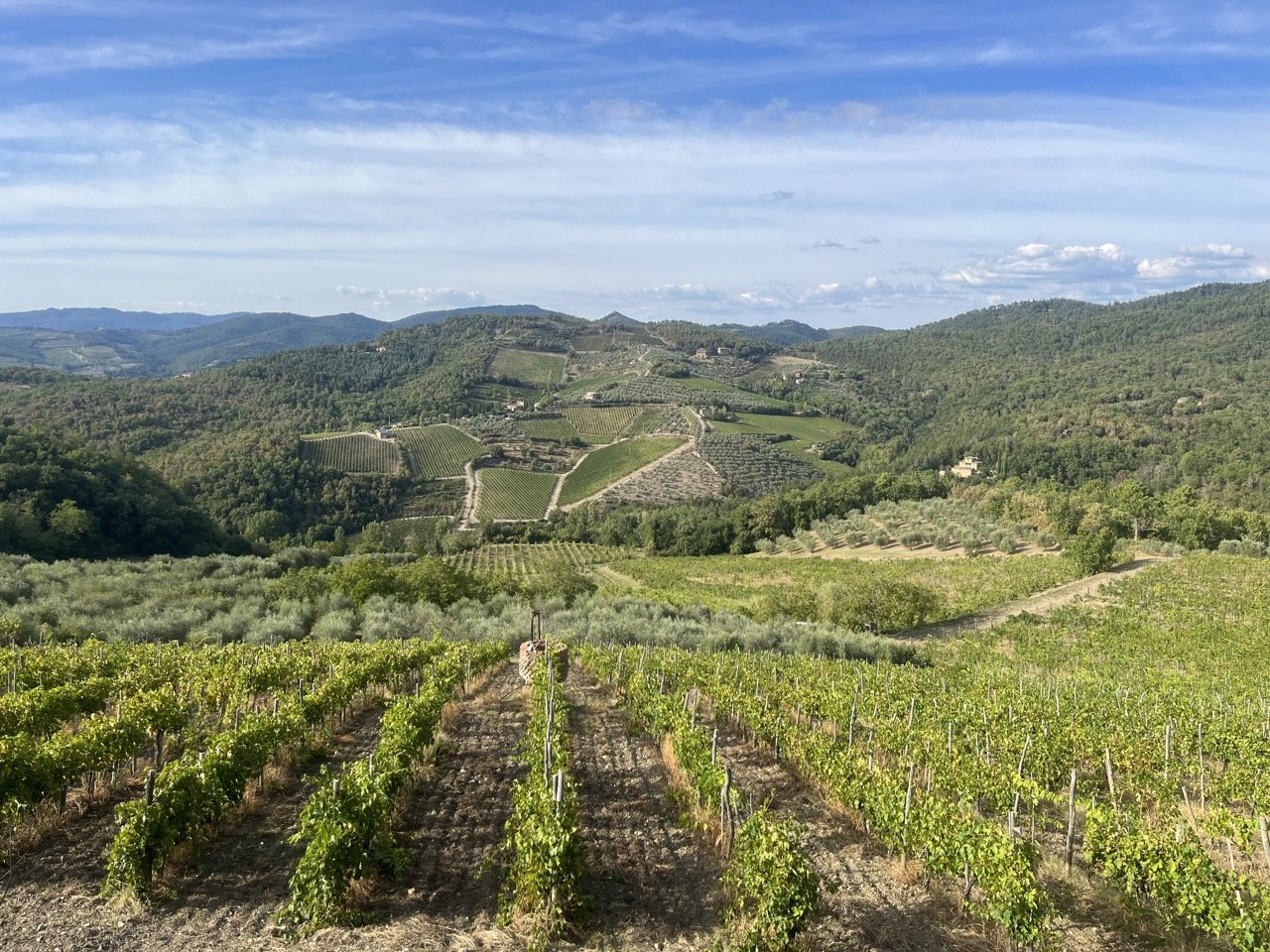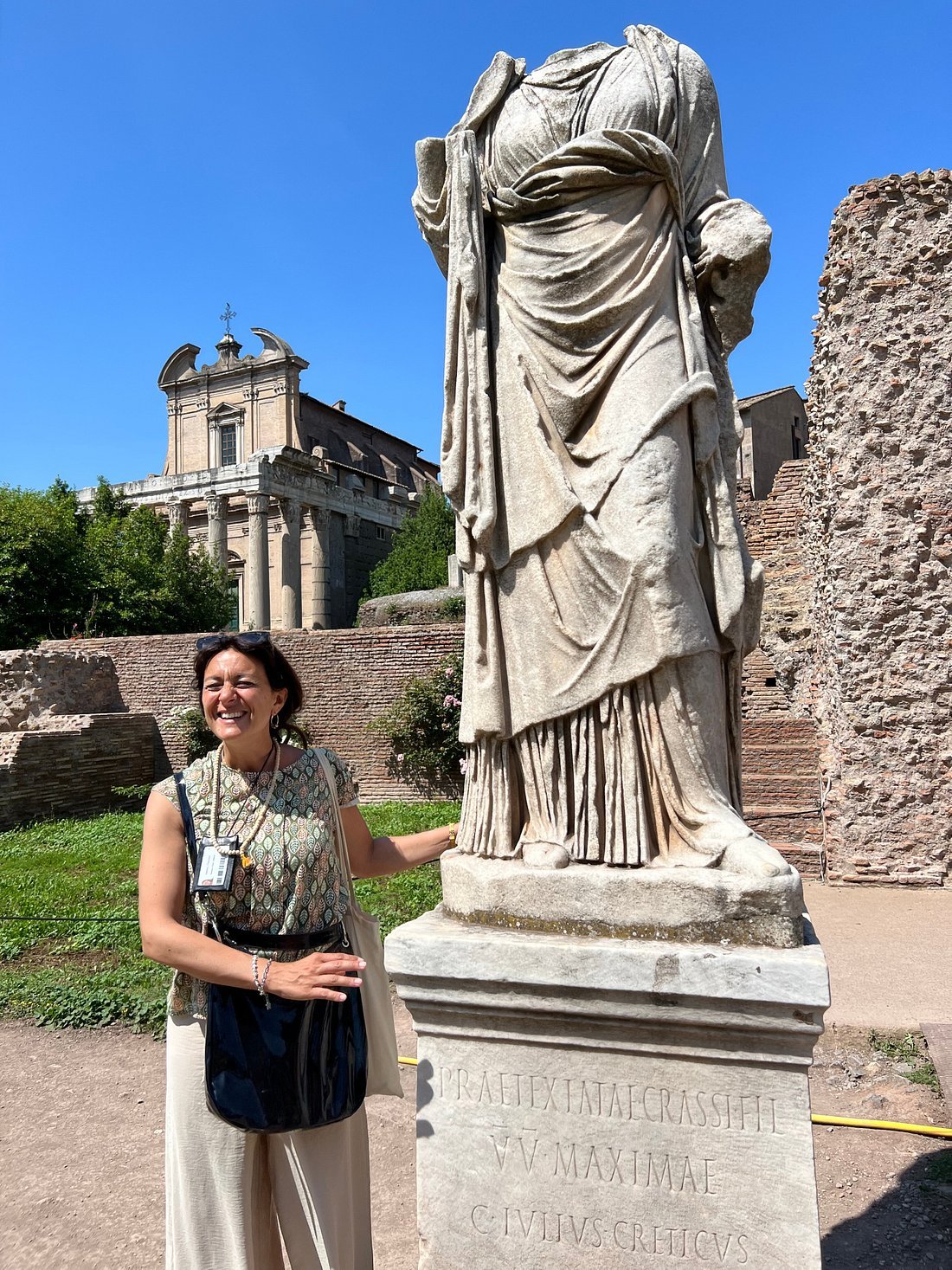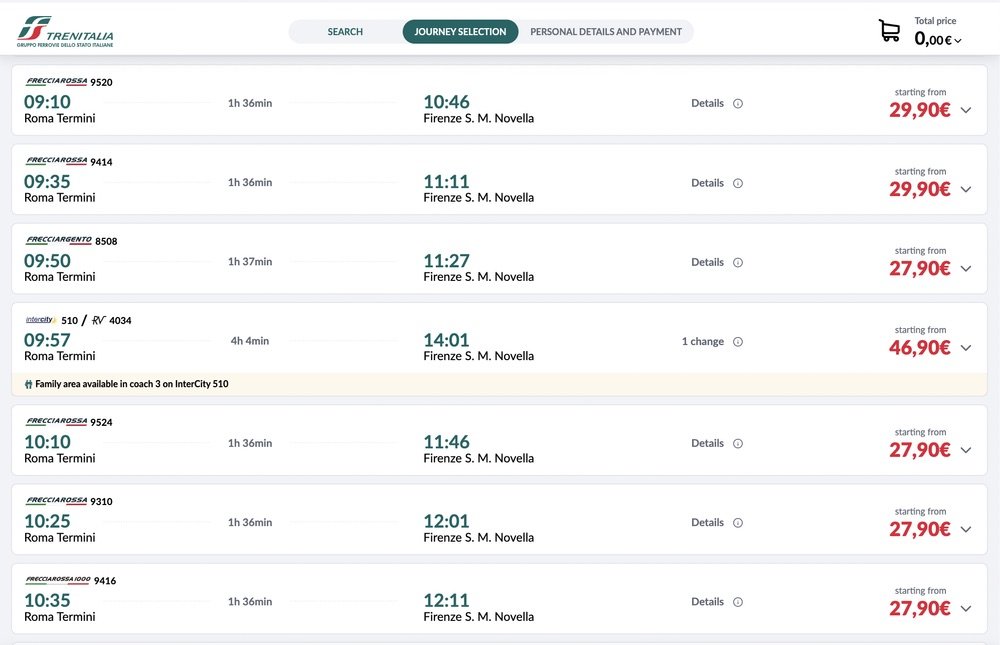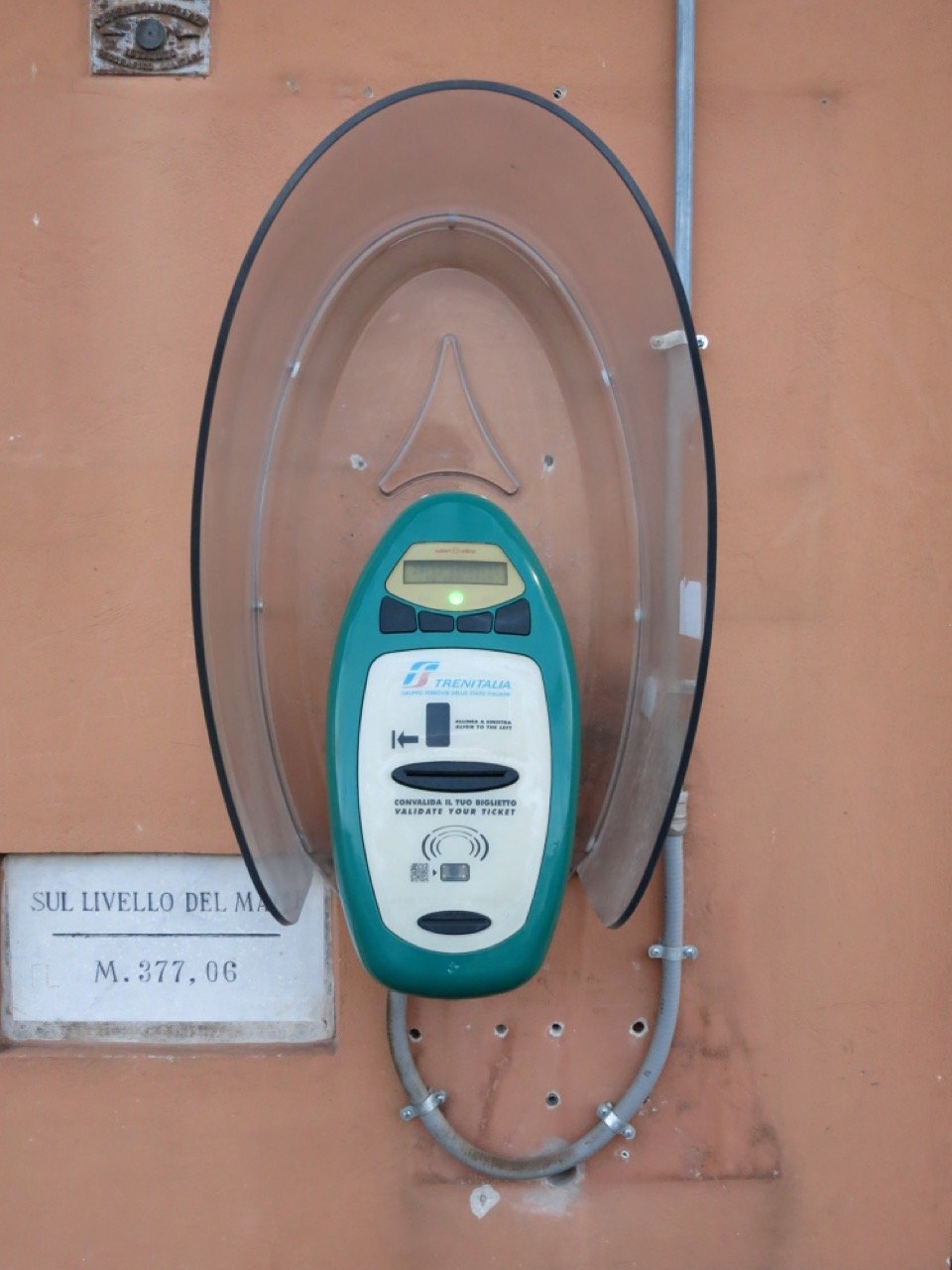Taking the train from Rome to Florence
Wondering about the best way to get from Rome to Florence by train? Wonder no more! Read on for detailed instructions on everything you need to know about your Rome to Florence journey.
The train is hands down the easiest, fastest, and most comfortable way to get from Rome to Florence. Florence is 274 kms (170 miles) north of Rome, and Trenitalia’s high-speed Frecciarossa trains make the journey from Roma Termini station to Florence’s Santa Maria Novella station in 1 hour and 40 minutes. Tickets usually cost 15-25 euros and you have multiple departures every hour.
Both Trenitalia (Italy’s national rail service) and ItaloTreno (a private company) run this route, combining for almost 100 daily departures.
Table of Contents
See more of our Tuscany travel guides:
Plan your itinerary with local help
If you could use some personalized help planning your Italy itinerary, schedule an Italy travel consultation with Dania, our Local Expert!
Dania is a local guide and trip planner who is based in Sicily and has been guiding and planning trips all over Italy for over twenty years!
Travel consultations are one-hour Zoom calls where you’ll get to chat with Dania about the trip you’re planning and she’ll share her tips and advice, answer your travel questions, and help you perfect your itinerary.
Traveling from Rome to Florence by Train
Roma Termini station to Florence Santa Maria Novella station
1 hour 36 minutes travel time
15-30 euro total cost
Book online at Trenitalia or Italo.
Two different train operators run this route: Trenitalia (the national rail service) and Italo (a private company). Both companies use the same tracks and the same train stations.
Trenitalia runs high-speed Frecciarossa trains from Rome’s Termini train station that arrive to Florence’s Santa Maria Novella station in just under 1 hour and 40 minutes. There are 2-5 departures every hour, beginning at 5:00 am and ending at just before 10:00 pm. You typically have 3-5 departures each hour from morning til evening, with service slowing to 2 departures per hour in the night. If purchased at least a month in advance, you’ll find tickets for as low as 14.90 euros. Last-minute tickets can cost 50 euros or more.
ItaloTreno runs 2-3 high-speed trains each hour, with service starting at 5:40 am and ending at 8:30 pm. The journey time is identical - about 1 hour and 40 minutes - and tickets cost the same; 13.90 euros and up. Like with Trenitalia, trains depart from Roma Termini station and arrive to S.M. Novella station.
All high-speed trains, regardless of whether you’re traveling with Trenitalia or Italo, make a single stop on the route between Roma Termini and Florence S.M. Novella: at Roma Tiburtina station. So, if your accommodation is closer to Tiburtina, you can get the high-speed trains from there as well.
The train journey is pleasant, passing through Rome’s urban sprawl before opening up into the countryside of Lazio, then Umbria, and finally Tuscany. You’ll pass pretty towns like Orte, Orvieto, and Montepulciano along your route and just might even catch a glimpse of hilltop Cortona in the distance.
There’s really no reason to ever use the slow Regionale or Intercity trains to get between Rome and Florence (they rarely cost any less than the Frecciarossa or Italo trains), but if you for some reason do wind up booking one, know that they typically depart from Tiburtina station, not Termini.
Train Stations in Rome
Rome has two major train stations: Roma Termini and Roma Tiburtina. There is also a station called Roma Ostiense, but it is little used. Termini and Tiburtina stations can both be reached via Rome’s metro system, with stations that connect directly with the train terminals.
Termini is the largest station in Rome and also the most centrally located. It has the most daily departures, with connections to everywhere in Italy. It is almost always the most convenient point of departure or arrival for tourists. If you arrive to Rome via Fiumicino airport and then take the “Leonardo Express” train into the city, for example, you’ll be arriving to Roma Termini.
Roma Termini
Termini station is just a few minutes walk from Rome’s city center and can be reached with both the A and B Metro lines, a host of buses, and a relatively inexpensive taxi fare. Termini recently underwent an extensive renovation and is now quite pleasant. You’ll find lots of restaurants, a market, ATMs, and a shopping gallery inside, as well as plenty of English-speaking staff. None of this can be said for Tiburtina.
Roma Tiburtina
Tiburtina station is located 3 km (2 miles) northeast of Termini station, and 4 stops away on the Metro. It lies on the Metro B line and can also be reached by bus and taxi, but it will take a little longer than Termini, especially with traffic.

Departure frequency and pricing
Trenitalia has 4-6 departures from Rome to Florence every hour, with most departing from Termini station. Most of the trains are direct high-speed Frecciarossa trains, but you will also find lower cost (and slower) Regionale, Regionale Veloce (RV), and Intercity (IC) trains. These trains make the journey in 3-4 hours. Most of the Frecciarossa trains will make a stop at Tiburtina station before continuing on to Florence without stopping again.
ItaloTreno has 2-3 departures each hour, all of them high speed.
Both Trenitalia and Italo have departures as early as 5:00 am. Trenitalia’s last departure from Rome to Florence is a little before 10:00 pm. Italo’s last train from Rome leaves for Florence at 8:40 pm.
Tickets cost 10-30 euro when purchased in advance. If you book your tickets closer to your dates, you can expect the price to increase significantly; last minute bookings could cost up to 4X more than advance bookings.
Trenitalia vs. Italo
When checking and booking train tickets in Italy, you have two companies and two websites to choose between: Trenitalia - www.trenitalia.com/ - and ItaloTreno (Italo) - www.italotreno.it/en.
Trenitalia is Italy’s national rail service and it runs far more routes and departures than Italo. It has high-speed Freccia trains as well as slower Regionale and Intercity trains, which are typically cheaper. Italo is a private company that exclusively operates high-speed trains on a few of Italy’s most heavily transited routes. All Italo trains are the equivalent of Trenitalia’s fastest “Frecciarossa” trains.
While some swear by one company or the other, we don’t think there’s much difference. Our advice is to simply pick whichever has the most convenient departure time for you and/or the best price.
All Italo trains have free Wifi while you’ll only get that luxury on Trenitalia’s Frecciarossa and Frecciaargento trains or in 1st class cabins on other trains. If you plan on surfing the internet instead of enjoying the countryside or chatting with your travel companions (boo!), this might be a big deal.
Another thing to keep in mind is that Italo’s trains are a bit newer than Trenitalia’s and, should strikes occur, their departures are often less affected given that it is a private company.
Where to buy train tickets
Your best bet is to purchase your tickets online on either company’s official website: https://www.trenitalia.com/ and https://www.italotreno.it/en. However, you can also purchase tickets directly at the station at a ticket window or on the electronic ticketing machines located just before the tracks.
Omio is also a convenient website/app to use if you want to compare options from both companies at the same time. It’s a 3rd party aggregator so tickets cost a bit more than booking direct, but comparing prices is easy, the site has a great design, and you can keep all your bookings in one place.
When to purchase your tickets
It’s always best to book your train tickets as far in advance as possible. For longer distance journeys in Italy, ticket prices increase the closer you get to your travel dates.
Intercity and Freccia trains increase in cost significantly as travel dates approach and last minute bookings could cost up to 4X more than advance bookings. Regionale trains, however, rarely vary in price, and seldom sell out, so there’s really no need to purchase them in advance.
Keep in mind that with Trenitalia tickets only become available 90-120 days before the date of travel. Therefore, you cannot purchase tickets more than 3-4 months in advance.
If you’re in a pinch and aren’t able to buy tickets in advance, you can also buy them aboard any train. There is a 5 euro surcharge for doing so, however. Also note that if buying a ticket aboard the train, you need to find the train conductor before they come to check your tickets. If you don’t and they arrive to find you without tickets, you can be fined.


Train classes and luggage storage
Rarely do we find ourselves feeling flush enough to consider business or first class travel, but if you’re operating with a little bit of room in your budget, it might be something you’re wondering about.
Most Trenitalia trains have two class levels: 1st and 2nd. However, Frecciarossa high-speed trains actually have 4 different classes, so we’ll get into that after first covering 1st vs. 2nd on all other trains.
Difference between 1st and 2nd class on Trenitalia
First things first, if there’s a big difference in price between first and second class, we never think that the upgrade is worth it. If the price difference is negligible, you might consider it though.
Both classes have seating in units of 4 seats with a 2 x 2 seat arrangement with rows of seats facing each other and a table in the middle. You have power outlets and overhead racks for luggage. There is almost always one bathroom per car.
On regular Trenitalia trains the major difference between the two classes is that 2nd class seats are cloth while 1st class are leather. The seats in 1st sometimes might be a bit bigger and the aisles a bit wider, but not necessarily. You will usually have more space for luggage in 1st and 1st class tickets usually entitles you to a free beverage or snack of some kind.
Frecciarossa train classes
If you didn’t have enough to think about already, with Frecciarossa trains you have 4 cabin classes: Standard, Premium, Business, Executive. All classes have free wifi, power sockets, overhead storage, and more storage at the beginning of the train. Eac Once we get to business and executive the seating layout changes.
Standard is just like 2nd class with the same layout and design.
Premium is identical to standard except for leather seats replace cloth and you get a complimentary drink included.
Business class becomes a bit more roomy. Seats are arranged 2 + 1 on one side of the aisle and 1 + 1 on the other, which is nice for couples. Each seating unit has a table. The leather seats are also larger than those in Standard or Premium, but do note that the leg room is the same. For those traveling in groups of 4, you can reserve a “salottino” which is a closed room with 4 seats. Business class also usually has a car that is reserved for silent seating, labeled as “business silenzio”.
Executive is the real deal if you’re up for a splurge. There are far fewer seats than in other classes (1 seat on each side and they do not face each other), the roomy leather seats recline, you have an included snack or meal, and free drinks; both alcoholic and non. To up the ante even more, you’ll have an attendant for your car and you get access to the Frecciaclub lounges at the train station.
Luggage storage
On Trenitalia 1st and 2nd class cars have the same type of luggage storage. There are overhead racks running the length of the seating area for backpacks and bags. The racks are quite deep, so you can usually fit even relatively large “checked” luggage.
Each car also has a location at the end of the car with additional non-overhead luggage storage for heavy items you don’t want to have to lift. If you’re traveling with copious baggage, the additional storage space of 1st class might be worth it.
On Frecciarossa trains you have similar luggage storage options, though the layout changes a bit for the different class cars.
Validating your ticket(s)
Photo: Alessandro Antonelli, CC BY 3.0, via Wikimedia Commons
If you buy your tickets at a train station, you will receive a printed ticket that needs to be validated before boarding the train. Validating tickets does not apply for tickets purchased online, which are already associated with your name and a specific departure date/time.
To validate your tickets, you’ll need to find one of the yellow or green ticket validation machines located at the beginning of each individual track. You must insert your ticket into the machine so that it can stamp them with a mark showing the current day and time. Machines are not typically located beyond the entrance to the track, so if you wait to validate until you’re next to your train carriage, you’ll find yourself having to sprint back to the machine.
Once you’re on the train, the conductor will come around and ask to see your tickets. If it’s been validated, he’ll clip a hole in the ticket and give it back to you. If you have not validated your ticket, you’ll probably be fined a substantial sum.
Frequently asked questions
What’s the fastest way to get from Rome to Florence?
The fastest way to get from Rome to Florence is to take a high-speed Trenitalia or Italo train, both of which will get you to Florence in just over 1 hour and 30 minutes.
How far is Florence from Rome?
Florence is 274 kms (170 miles) north of Rome, about 3 hours by car, but only 1.5 hours by high-speed train.
Is the train from Rome to Florence scenic?
Parts of the journey are scenic, though not exceedingly so. Most of the time you’ll just be passing through flat agricultural fields that are rather nondescript. Also, the high-speed train goes quite fast, so it really doesn’t lend itself well to watching the scenery.
Can you visit Florence as a day trip from Rome?
Given that the train between Rome and Florence is very fast and that departures run frequently from early morning until late in the evening, you can easily visit Florence as a day trip from Rome. However, Florence is a wonderful city full of great art, beautiful monuments, and terrific restaurants, and it is worth more than just a quick visit.
For a fabulous local guide who runs private tours in both Rome and Florence, check out the wonderful Francesca.
Do you need to buy train tickets in advance?
Because trains between Rome and Florence are so frequent, they rarely, if ever, sell out, meaning that you don’t need to buy tickets in advance. Tickets can be purchased directly at the train station in Rome, either via the ticket counter or at automated kiosks, and they can be purchased with cash or card. However, prices rise dramatically as you get closer to your travel dates, so buying tickets last minute is almost always more expensive than doing so in advance.
Can you bring luggage on the train from Rome to Florence?
Of course! All trains in Italy have luggage storage locations, usually at the end of each car and then in overhead bins above the seating area. There is no fee for bringing luggage.
Are there bathrooms on the trains?
All trains in Italy have bathrooms, usually at least one in every car.



Plan with Dania




















